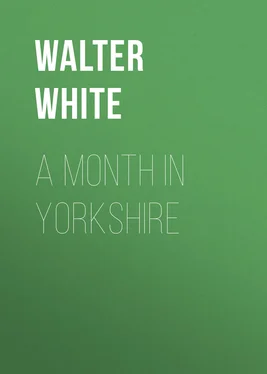Walter White - A Month in Yorkshire
Здесь есть возможность читать онлайн «Walter White - A Month in Yorkshire» — ознакомительный отрывок электронной книги совершенно бесплатно, а после прочтения отрывка купить полную версию. В некоторых случаях можно слушать аудио, скачать через торрент в формате fb2 и присутствует краткое содержание. Жанр: Путешествия и география, История, foreign_edu, foreign_antique, foreign_prose, на английском языке. Описание произведения, (предисловие) а так же отзывы посетителей доступны на портале библиотеки ЛибКат.
- Название:A Month in Yorkshire
- Автор:
- Жанр:
- Год:неизвестен
- ISBN:нет данных
- Рейтинг книги:3 / 5. Голосов: 1
-
Избранное:Добавить в избранное
- Отзывы:
-
Ваша оценка:
- 60
- 1
- 2
- 3
- 4
- 5
A Month in Yorkshire: краткое содержание, описание и аннотация
Предлагаем к чтению аннотацию, описание, краткое содержание или предисловие (зависит от того, что написал сам автор книги «A Month in Yorkshire»). Если вы не нашли необходимую информацию о книге — напишите в комментариях, мы постараемся отыскать её.
A Month in Yorkshire — читать онлайн ознакомительный отрывок
Ниже представлен текст книги, разбитый по страницам. Система сохранения места последней прочитанной страницы, позволяет с удобством читать онлайн бесплатно книгу «A Month in Yorkshire», без необходимости каждый раз заново искать на чём Вы остановились. Поставьте закладку, и сможете в любой момент перейти на страницу, на которой закончили чтение.
Интервал:
Закладка:
And yonder, near the bottom of the curve, stood the town variously described as Ravenser, Ravenspurne, and Ravenspurg—a town that sent members to parliament in the reigns of the first two Edwards, and was considered of sufficient importance to be invited to take part in the great councils held in London, when the “kinge’s majestie” desired to know the naval forces of the kingdom. Now, twice a day, the tide rolls in triumphantly over its site.
“The banish’d Bolingbroke repeals himself,
And with uplifted arms is safe arriv’d
At Ravenspurg,”
writes Shakspeare, perpetuating alike the name of the place and the memory of the Duke of Lancaster’s adventure,—an adventure brought before us in an invective by the fiery Hotspur, which I may, perhaps, be pardoned for introducing here:
“My father, my uncle, and myself,
Did give him that same royalty he wears:
And,—when he was not six and twenty strong,
Sick in the world’s regard, wretched and low,
A poor unminded outlaw, sneaking home,—
My father gave him welcome to the shore:
And,—when he heard him swear a vow to God,
He came but to be Duke of Lancaster,
To sue his livery, and beg his peace;
With tears of innocency and terms of zeal,—
My father, in kind heart and pity mov’d,
Swore him assistance, and performed it too.
Now, when the lords and barons of the realm
Perceived Northumberland did lean to him,
The more and less came in with cap and knee;
Met him in boroughs, cities, villages;
Attended him on bridges, stood in lanes,
Laid gifts before him, proffered him their oaths,
Gave him their heirs; as pages follow’d him,
Even at the heels, in golden multitudes.
He presently,—as greatness knows itself,—
Steps me a little higher than his vow
Made to my father, while his blood was poor,
Upon the naked shore at Ravenspurg.”
The cross set up to commemorate the landing was shifted from place to place when endangered by the sea, and lastly to Hedon, where it still remains, as already mentioned. It was at the same port that Edward IV. landed, with an excuse plausible as that of the duke whose exploit he imitated.
Though it be “naked” still, and toilsome to walk on, the shore is by no means barren of interest. By-and-by we come to firm ground, mostly covered with thickly-matted grass; a great irregular, oval mound, which represents the bowl of the spoon reversed. Near its centre is a fenced garden and a row of cottages—the residence of the life-boat crew. A little farther, on the summit of the ridge, stands the lighthouse, built by Smeaton, in 1776, and at the water’s edge, on the inner side, the lower light. The principal tower is ninety feet in height, and from the gallery at the top you get an excellent bird’s-eye view over sea and land. Most remarkable is the tongue of sand along which we have walked, now visible in its whole extent and outline. It is lowest where the breach was made, and now that the tide has risen higher, the chalk embankment seems scarcely above the level of the water. Beyond that it broadens away to the shore of the estuary on one side, and the coast of Holderness on the other—low, sweeping lines which your eye follows for miles. By the waste of that coast the Spurn is maintained, and the Trinity Sands are daily enlarged, and the meadows fattened along Ouse and Trent. First the lighter particles of the falling cliffs drift round by the set of the current, and gradually the heavier portions and pebbles follow, and the supply being inexhaustible, a phenomenon is produced similar to that of the Chesil Bank, on the coast of Dorsetshire, except that here the pebbles are for the most part masked by sand.
I looked northwards for Flamborough Head, but Dimlington Hill, which lies between, though not half the height, hides it completely. Beyond Dimlington lies Withernsea, a small watering-place, the terminus of the Hull and Holderness Railway, to which the natives of the melancholy town betake themselves for health and recreation, tempted by a quadrille band and cheap season-tickets. Adjoining Withernsea is all that remains of Owthorne, a village which has shared the doom of Kilnsea. The churches at the two places were known as ‘sister churches;’ that at Withernsea yet stands in ruins; but Owthorne church was swept into the sea within the memory of persons now living. The story runs that two sisters living there, each on her manor, in the good old times, began to build a church for the glory of God and the good of their own souls, and the work went on prosperously until a quarrel arose between them on the question of spire or tower. Neither would yield. At length a holy monk suggested that each sister should build a church on her own manor; the suggestion was approved, and for long years the Sister Churches resounded with the voice of prayer and praise, and offered a fair day-mark to the mariner.
But, as of old, the devouring sea rushed higher and higher upon the land, and the cliff, sapped and undermined, fell, and with it the church of Owthorne. In 1786, the edge of the burial-ground first began to fail; the church itself was not touched till thirty years later. It was a mournful sight to see the riven churchyard, and skeletons and broken coffins sticking out from the new cliff, and bones, skulls, and fragments of long-buried wood strewn on the beach. One of the coffins washed out from a vault under the east end of the church contained an embalmed corpse, the back of the scalp still bearing the gray hairs of one who had been the village pastor. The eyes of the villagers were shocked by these ghastly relics of mortality tossed rudely forth to the light of day; and aged folk who tottered down to see the havoc, wept as by some remembered token they recognised a relative or friend of bygone years, whom they had followed to the grave—the resting place of the dead, as they trusted, till the end of time. In some places bodies still clad in naval attire, with bright-coloured silk kerchiefs round the neck, were unearthed, as if the sea were eager to reclaim the shipwrecked sailors whom it had in former time flung dead upon the shore.
But, to return to the lighthouse. According to Smeaton’s survey this extremity of the spoon comprehends ninety-eight acres. It slopes gently to the sea, and is somewhat altered in outline by every gale. At the time of my visit, rows of piles were being driven in, and barriers of chalk erected, to secure the ground on the outer side between the tower and the sea; and a new row of cottages for the life-boat crew, built nearer to the side where most wrecks occur than the old row, was nearly finished. Beyond, towards the point, stands a public-house, in what seems a dangerous situation, close to the water. There was once a garden between it and the sea; now the spray dashes into the rear of the house; for the wall and one-half of the hindermost room have disappeared along with the garden, and the hostess contents herself with the rooms in front, fondly hoping they will last her time. She has but few guests now, and talks with regret of the change since the digging of ballast was forbidden on the Spurn. Then trade was good, for the diggers were numerous and thirsty. That ballast-digging should ever have been permitted in so unstable a spot argues a great want of forethought somewhere.
The paved enclosure around the tower is kept scrupulously clean, for the rain which falls thereon and flows into the cistern beneath is the only drinkable water to be had. “It never fails,” said the keeper, “but in some seasons acquires a stale flavour.” He was formerly at Flamborough, and although appointment to the Spurn was promotion, he did not like it so well. It was so lonesome; the rough, trackless way between, made the nearest village seem far off; now and then a boat came across with visitors from Cleathorpes, a seven miles’ trip; there had been one that morning, but not often enough to break the monotony. And he could not get much diversion in reading, for the Trinity Board, he knew not why, had ceased to circulate the lighthouse library.
Читать дальшеИнтервал:
Закладка:
Похожие книги на «A Month in Yorkshire»
Представляем Вашему вниманию похожие книги на «A Month in Yorkshire» списком для выбора. Мы отобрали схожую по названию и смыслу литературу в надежде предоставить читателям больше вариантов отыскать новые, интересные, ещё непрочитанные произведения.
Обсуждение, отзывы о книге «A Month in Yorkshire» и просто собственные мнения читателей. Оставьте ваши комментарии, напишите, что Вы думаете о произведении, его смысле или главных героях. Укажите что конкретно понравилось, а что нет, и почему Вы так считаете.












